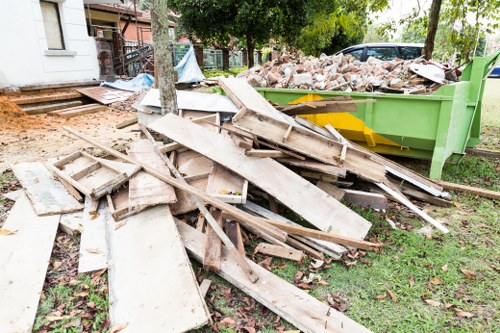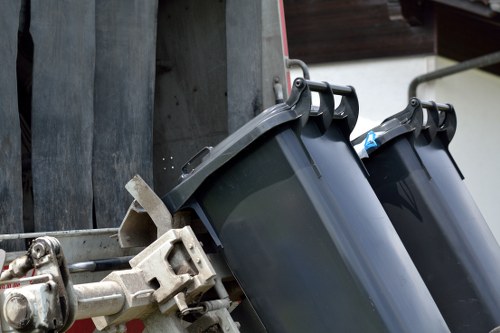Site Clearance in Temple: Ensuring a Sacred Space

Temple site clearance is a crucial process that involves preparing a sacred space for construction, renovation, or maintenance. This procedure ensures that the temple environment remains pristine, safe, and conducive to spiritual activities. Proper site clearance not only involves physical removal of debris and unnecessary structures but also respects the cultural and religious significance of the temple.
In the context of temple maintenance, site clearance is essential for preserving the sanctity and functionality of the space. It encompasses a range of activities, from removing old structures to managing waste and ensuring that the area is free from hazards. This process is vital for maintaining the temple as a place of worship and community gathering.
Effective site clearance requires a thorough understanding of the temple's architectural and cultural elements. It involves careful planning and execution to ensure that the delicate balance between construction and preservation is maintained. Professionals involved in the process must be sensitive to the temple's heritage and work diligently to protect its integrity.
Why Site Clearance is Important for Temples

Site clearance plays a pivotal role in the upkeep and enhancement of temple premises. By removing outdated structures and debris, the temple can be redeveloped to better serve the needs of the community. This not only improves the aesthetics of the space but also ensures that it meets modern safety standards.
Moreover, site clearance is essential for implementing new facilities within the temple complex. Whether it's constructing new prayer halls, expanding existing areas, or adding amenities for visitors, a clear and organized site is necessary for successful development. This process paves the way for innovations that can enhance the spiritual experience for devotees.
Environmental considerations are also a significant aspect of site clearance in temples. Proper disposal of waste and sustainable practices during the clearance process contribute to the ecological health of the surrounding area. Temples often play a central role in their communities, and maintaining an environmentally responsible site reflects their commitment to stewardship.
The Site Clearance Process for Temples

The site clearance process in temples typically involves several key steps to ensure thorough and respectful preparation. These steps include:
- Assessment and Planning: Evaluating the current state of the temple site, identifying areas that require clearance, and developing a detailed plan of action.
- Permitting and Compliance: Obtaining necessary permits and ensuring that the clearance activities comply with local regulations and religious guidelines.
- Debris Removal: Systematically removing debris, old structures, and any materials that are no longer needed. This step includes the safe disposal or recycling of materials.
- Site Preparation: Preparing the cleared site for subsequent construction or renovation activities. This may involve leveling the ground, reinforcing foundations, or installing necessary infrastructure.
- Final Inspection: Conducting a thorough inspection to ensure that the site meets all requirements and is ready for the next phase of development.
Tools and Equipment Used in Temple Site Clearance

Executing site clearance in temples requires specific tools and equipment to ensure efficiency and safety. The selection of appropriate machinery is vital to handle the unique challenges presented by temple sites, which often include intricate architectural details and historical artifacts.
Some of the essential tools and equipment used in temple site clearance include:
- Excavators: For digging and removing large amounts of earth or debris.
- Bulldozers: To push large quantities of material and streamline the clearance process.
- Hand Tools: Such as hammers, chisels, and pry bars for delicate tasks that require precision.
- Waste Management Systems: Including dumpsters and recycling units to handle removed materials responsibly.
- Safety Gear: Personal protective equipment (PPE) like helmets, gloves, and masks to ensure the safety of the workers.
Proper use and maintenance of these tools are essential to minimize disruptions and preserve the temple's integrity during the clearance process.
Challenges in Temple Site Clearance

Clearing a temple site presents several unique challenges that must be addressed to ensure a smooth and respectful process. One of the primary challenges is preserving the temple's historical and cultural elements. Temples often contain artifacts, artwork, and architectural features that are of significant value, requiring careful handling during clearance.
Another challenge is managing the environmental impact of site clearance activities. Ensuring that waste is disposed of responsibly and that the surrounding ecosystem is not adversely affected is crucial. This requires adherence to environmental regulations and the implementation of sustainable practices.
Additionally, coordinating with religious leaders and community members can be complex. Balancing the need for modernization or expansion with the community's spiritual needs and expectations requires effective communication and collaboration.
Best Practices for Effective Site Clearance in Temples

To achieve successful site clearance in temples, adhering to best practices is essential. These practices help in minimizing disruptions, preserving sacred elements, and ensuring the overall effectiveness of the clearance process.
Some best practices include:
- Comprehensive Planning: Developing a detailed clearance plan that outlines each step, timelines, and responsibilities can prevent oversights and ensure smooth execution.
- Engaging Professionals: Hiring experienced contractors and specialists who understand the unique requirements of temple sites is crucial for maintaining the site's sanctity.
- Community Involvement: Involving community members in the planning process fosters transparency and ensures that the clearance activities align with the community's values and needs.
- Environmental Responsibility: Implementing eco-friendly practices, such as recycling materials and minimizing waste, supports the temple's role as a guardian of the environment.
- Regular Monitoring: Continuously monitoring the clearance process helps in identifying and addressing any issues promptly, ensuring that standards are maintained throughout.
Regulatory Compliance in Temple Site Clearance

Compliance with local and national regulations is a critical aspect of temple site clearance. These regulations may pertain to environmental protection, waste management, construction standards, and historical preservation.
Ensuring that all necessary permits are obtained and that the clearance activities adhere to legal requirements helps in avoiding potential legal issues and penalties. It also demonstrates the temple's commitment to responsible stewardship of its property and the surrounding environment.
Additionally, adhering to religious guidelines and obtaining approvals from relevant religious authorities ensures that the clearance process respects the temple's spiritual significance and traditions.
Benefits of Professional Site Clearance Services for Temples

Employing professional site clearance services offers numerous benefits for temples. These services bring expertise, efficiency, and reliability to the clearance process, ensuring that it is conducted smoothly and respectfully.
Some key benefits include:
- Expertise: Professionals are trained to handle the specific challenges associated with temple site clearance, including the preservation of cultural and historical elements.
- Efficiency: Experienced clearance teams can complete the process more quickly and effectively, minimizing disruptions to temple activities.
- Safety: Professional services adhere to safety standards, protecting both workers and temple visitors from potential hazards during clearance.
- Cost-Effectiveness: While hiring professionals may incur initial costs, their expertise often leads to cost savings by preventing damage and ensuring proper waste management.
- Peace of Mind: Knowing that the clearance is being handled by experts allows temple administrators to focus on their core responsibilities and spiritual activities.
Environmental Sustainability in Temple Site Clearance

Environmental sustainability is increasingly important in temple site clearance. Adopting sustainable practices not only protects the environment but also aligns with many religious teachings that emphasize the stewardship of nature.
Key sustainability practices include:
- Recycling and Reuse: Minimizing waste by recycling materials and reusing existing structures when possible reduces the environmental footprint of the clearance process.
- Energy Efficiency: Utilizing energy-efficient equipment and machinery can lower energy consumption and operational costs.
- Natural Landscaping: Preserving existing vegetation and incorporating native plants in landscaping efforts maintains the ecological balance of the temple grounds.
- Water Conservation: Implementing water-saving measures during construction and maintenance helps in preserving this vital resource.
By prioritizing sustainability, temples can contribute positively to environmental conservation while maintaining their sacred spaces.
Case Studies: Successful Temple Site Clearance Projects

Looking at successful case studies provides valuable insights into effective temple site clearance practices. These examples highlight the importance of planning, community involvement, and professional execution.
One notable example is the renovation of the historic Shri Krishna Temple, where a meticulous site clearance process preserved intricate carvings and artwork while upgrading the facilities to accommodate more visitors. The project team worked closely with religious leaders to ensure that the clearance activities respected the temple's traditions.
Another case is the Ganesha Mandir Expansion, where professional site clearance services enabled the seamless addition of new prayer halls and community spaces. The project emphasized environmental sustainability by incorporating green practices, such as rainwater harvesting and solar energy usage.
Future Trends in Temple Site Clearance

The field of temple site clearance is evolving with advancements in technology and increasing emphasis on sustainability. Future trends are likely to focus on integrating smart technologies, enhancing environmental practices, and fostering greater community involvement.
Some anticipated trends include:
- Smart Technology Integration: Utilizing advanced tools like drones for site surveying and monitoring can enhance the efficiency and accuracy of clearance operations.
- Green Building Practices: Incorporating eco-friendly materials and construction methods will become standard, promoting sustainability in temple development projects.
- Enhanced Preservation Techniques: Developing innovative methods for preserving historical and cultural elements during clearance and renovation will ensure the longevity of temple heritage.
- Community-Driven Projects: Increasingly, temple site clearance projects will involve active participation from the community, fostering a sense of ownership and collective responsibility.
Conclusion

Site clearance in temples is a vital process that combines practical, environmental, and cultural considerations to maintain and enhance sacred spaces. By adhering to best practices, engaging professional services, and prioritizing sustainability, temples can ensure that their sites remain sanctified, functional, and welcoming for generations to come.
Whether undertaking renovation, expansion, or regular maintenance, effective site clearance is key to preserving the spiritual and communal essence of temples. Embracing thoughtful and respectful clearance strategies supports the continued role of temples as pillars of faith and community.
Contact us today to learn more about our specialized site clearance services tailored for temples and sacred spaces. Book your service now and ensure the preservation and enhancement of your temple's sacred environment.